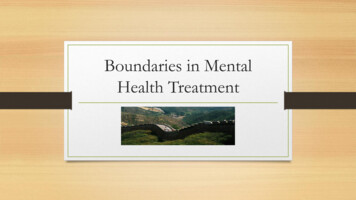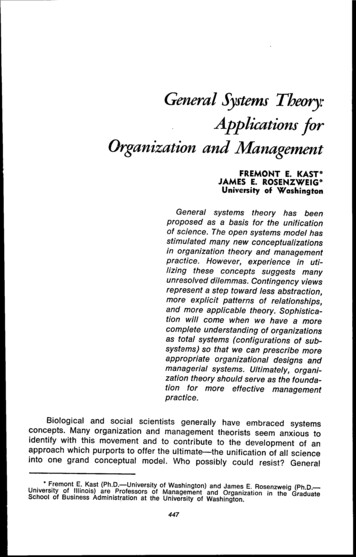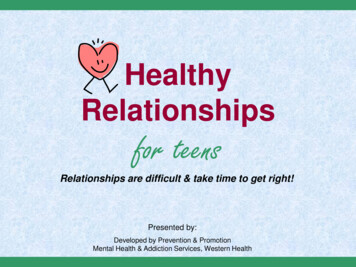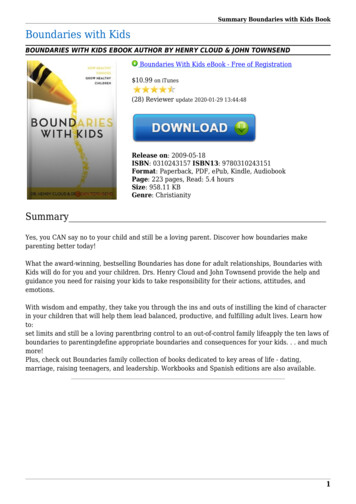
Transcription
Boundaries in MentalHealth Treatment
Boundaries Establishing boundaries is an important competencyBoundaries delineate personal and professional rolesBoundaries are essential to patient and therapist safetyProfessional relationships with patients exist for their benefitWhose needs are being met in this relationship, my patient’s or my own?
“Boundaries define the helping pathwayfor patients and professionals and areintegral to professional effectiveness.”(Everett and Gallop, 2001)
Boundary Crossings v. Boundary Violations A boundary crossing is a “decision to deviate from an established boundaryfor a specific purpose- a brief excursion with a return to the establishedlimits of a professional relationship”(Peternelj-Taylor, 2003). A boundary crossing is also “any activity that moves the clinician from astrictly objective position ” (Guthriel and Gabbard, 1993). Boundary crossings may be minor and may even be therapeutic A boundary crossing becomes a violation when it becomes harmful to thepatient. It can be difficult to assess when harm is caused.
Boundary Crossings Taking phone calls between sessions(if not an emergency orpreviously agreed upon) Small gifts(giving and accepting) Extending time beyond what was initially agreedSpecial fee arrangements or barteringAllowing patients to run a large balanceExcessive therapist self-disclosure/disclosure of personalinformationSaying “yes” rather than “no”Making special allowances for a patientNon-emergency meetings outside of the office or after office hours
Boundary Violations Avoidable dual or multiple relationships Sexual relationshipsAn important consideration of what causes harmto the patient is not the clinician’s intent or evennecessarily the clinician’s behavior, but themeaning of the behavior to the patient.
A clinicians’ duty is to know well his orher personal and professional identities;be aware of the distinction between thetwo, and preserve this distinction in thetherapeutic framework(Sakar, 2004).
Why Boundary Problems OccurInability to differentiate professionalfrom personal relationship Treatment environment Challenging patientsAttempting to have personal needsmet through therapist/patientrelationship Therapist difficulties with limit settingUse of touchCaretaking, rescuingTherapist self-disclosure
Therapists’ GettingPersonal Needs MetPersonal life of the therapist Excessive need to please Personal life crisis Balancing demands of familyand professional life
Therapists’ GettingPersonal Needs Met Limit-setting Touch Caretaking Therapist Self-disclosure
Challenging PatientPopulations/Patient Factors Enmeshment Re-traumatization Shame and self blame Personality disorders
Informed Consent Legal and ethical procedure to ensure that a patient knows all of the risks and costsof mental health treatment- a collaborative process of communication andclarification Provide informed consent as soon as possible in the therapeutic relationship: natureof treatment, possible alternative treatments, potential risks and benefits, exceptionsto confidentiality, record keeping requirements, right to rescind consent, time frameof consent Make fee arrangements, bartering, any potential areas for boundary crossings, clearat the outset
HIPPA Informed consent should include summary of HIPPA PHI- protected health information- any information about health status,provision of health care or payment for health care Provide patients with a Notice of Privacy Practices- rights about release ofinformation: treatment issues, payment, exceptions to confidentiality,sensitive health information, right of access to records
Conflicts of Interest Entering into a businessrelationship with a patient or apatient’s close relative Self-referring to one’s own privatepractice from a hospital setting Providing paid testimony for legalservices with an existing therapypatient
Exploitive Relationships Encouraging expensive gifts from patients Starting to see patients at a lower fee then increasing the fee after a fewsessions Recommending services that are unnecessary and not affordable to patients
Multiple or Non-Sexual Dual Relationships Social relationships Bartering Being a treating professional andproviding court testimony Providing individual and grouptherapyNeed for boundaries thesereasons: Protection of the therapeuticprocess Protection of patients fromexploitation Protection from liability
Unavoidable Relationships Assess future and currentrelationship on the dimensions ofpower, duration, and termination Determine the extent of roleincompatibility Seek consultation Discuss decision with patient interms of possible ramifications
Unethical Multiple Relationships Erode and distort the professional nature ofthe therapeutic relationship, which is securedwithin a reliable set of boundaries upon whichboth therapist and patient depend Create conflicts of interest and compromisesound professional judgment Unequal footing between therapist and patient Nature of therapy changes Could affect future needs of patient
Unethical Multiple Relationships Entering into another roleRelationships with othersPreexisting personal relationshipsSexual relationships
Consequences of Boundary Violations toPatient Disengagement from servicesDepressionEmotional turmoilCognitive distortionShame, fear, or rageGuilt and self-blame Isolation and emptinessIdentity confusionEmotional labilityMistrust of authoritySelf-harm behaviors
Consequences of Boundary Violations toTherapist Less personal time with family and friendsLess job satisfactionCo-worker frustrationsBurnoutExtreme consequences- loss of job, loss of license, loss of professionalidentity, loss of peers, loss of professional relationships
Prevention of BoundaryCrossings or Violations EducationSelf-awareness and monitoringPeer debriefing/consultationWhose needs are being met in this interaction, thepatient’s or my own?
References Adapted from: er E052Course author: Dalzell, Heidi, Psy.D.
Boundary Crossings v. Boundary Violations A boundary crossing is a "decision to deviate from an established boundary for a specific purpose- a brief excursion with a return to the established limits of a professional relationship"(Peternelj-Taylor, 2003). A boundary crossing is also "any activity that moves the clinician from a strictly objective position " (Guthriel and .











